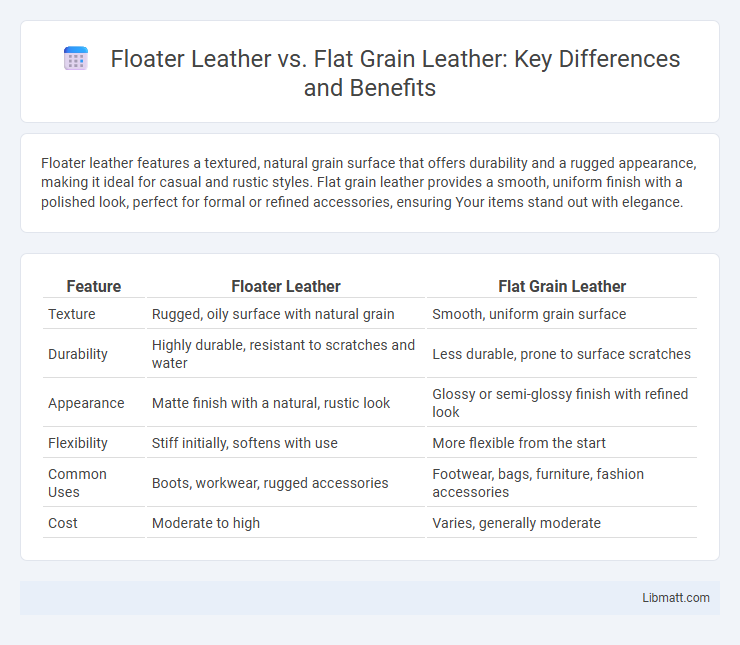Floater leather features a textured, natural grain surface that offers durability and a rugged appearance, making it ideal for casual and rustic styles. Flat grain leather provides a smooth, uniform finish with a polished look, perfect for formal or refined accessories, ensuring Your items stand out with elegance.
Table of Comparison
| Feature | Floater Leather | Flat Grain Leather |
|---|---|---|
| Texture | Rugged, oily surface with natural grain | Smooth, uniform grain surface |
| Durability | Highly durable, resistant to scratches and water | Less durable, prone to surface scratches |
| Appearance | Matte finish with a natural, rustic look | Glossy or semi-glossy finish with refined look |
| Flexibility | Stiff initially, softens with use | More flexible from the start |
| Common Uses | Boots, workwear, rugged accessories | Footwear, bags, furniture, fashion accessories |
| Cost | Moderate to high | Varies, generally moderate |
Introduction to Floater Leather and Flat Grain Leather
Floater leather is a type of full-grain leather known for its natural, textured surface created by leaving the grain intact and applying a protective finish that enhances durability and water resistance. Flat grain leather, also a full-grain variety, features a smooth, uniform surface achieved by carefully shaving and polishing the hide to remove imperfections while maintaining strength and longevity. Both leathers offer high quality, with floater leather favored for rugged, rustic aesthetics and flat grain leather prized for sleek, refined appearances.
Defining Floater Leather: Features and Characteristics
Floater leather is characterized by its soft, flexible texture created by treating the grain side to highlight natural markings and enhance its rugged appearance. Unlike flat grain leather, floater leather retains natural blemishes and wrinkles, providing a unique, vintage look with increased durability due to the full-grain layer. Your choice of floater leather offers superior breathability and a distinct texture ideal for casual and rustic leather goods.
Understanding Flat Grain Leather: Key Attributes
Flat grain leather features a smooth, uniform surface created by using the top layer of the hide without embossing or treatment, preserving its natural texture and strength. Known for its durability and resistance to wear, flat grain leather maintains breathability while developing a rich patina over time. This leather type offers a sleek appearance ideal for premium leather goods that demand both aesthetic appeal and long-lasting performance.
Production Processes: Floater vs Flat Grain Leather
Floater leather is produced from the outer surface of the hide, retaining the natural grain and texture with minimal processing to preserve its rugged appearance. Flat grain leather undergoes more extensive buffing and sanding to create a smoother, uniform surface by removing natural imperfections. The differing production processes result in floater leather offering enhanced durability and a more rustic look, while flat grain leather provides a refined, polished finish ideal for premium leather goods.
Texture and Appearance Differences
Floater leather features a pronounced, pebbled texture with natural grain displays and unique wrinkles, giving it a rugged, rustic appearance. Flat grain leather is smooth with a consistent surface and minimal natural markings, offering a sleek and refined look. The robust texture of floater leather enhances durability and character, while flat grain leather emphasizes elegance and uniformity.
Durability and Performance Comparison
Floater leather offers superior durability due to its natural grain texture, which resists scratches and wear better than flat grain leather's smooth surface. Flat grain leather, while visually sleek and elegant, tends to show scratches and scuffs more prominently, making it less ideal for heavy-duty use. Your choice between the two should consider the balance between rugged performance and refined appearance based on daily wear demands.
Suitability for Different Products
Floater leather, with its natural grain and rugged texture, is ideal for casual footwear, jackets, and bags that benefit from durability and a vintage appearance. Flat grain leather, featuring a smooth and uniform surface, suits formal shoes, high-end handbags, and upholstery where a polished, refined look is desired. Each type's unique finish determines its optimal use across fashion and accessory products.
Maintenance and Care Considerations
Floater leather requires minimal maintenance due to its naturally oily and waxy surface, which repels water and hides scratches effectively. Flat grain leather demands regular conditioning and careful cleaning to prevent drying and cracking, as its smooth surface is more susceptible to visible damage. Proper ventilation and avoiding prolonged exposure to moisture are essential for both types to maintain longevity.
Price Points and Market Value
Floater leather typically commands higher price points due to its premium quality, durability, and distinctive textured grain that appeals to luxury markets. Flat grain leather, while still valued for its smooth and consistent surface, generally occupies a lower to mid-range market segment because it is more common and easier to produce. Your choice between the two can significantly impact the overall cost and market value of leather goods, with floater leather often seen as a long-term investment in quality and exclusivity.
Choosing Between Floater Leather and Flat Grain Leather
Selecting between floater leather and flat grain leather depends on desired texture and durability; floater leather offers a rugged, pebble-like grain with natural oils for water resistance, while flat grain leather provides a smooth, refined surface with less pronounced texture. Floater leather excels in toughness and aging, developing unique patinas from scratches and wear, whereas flat grain leather emphasizes elegance and uniformity, ideal for formal accessories. Considering use cases and maintenance preferences helps determine the optimal leather type for longevity and aesthetic appeal.
Floater leather vs flat grain leather Infographic

 libmatt.com
libmatt.com